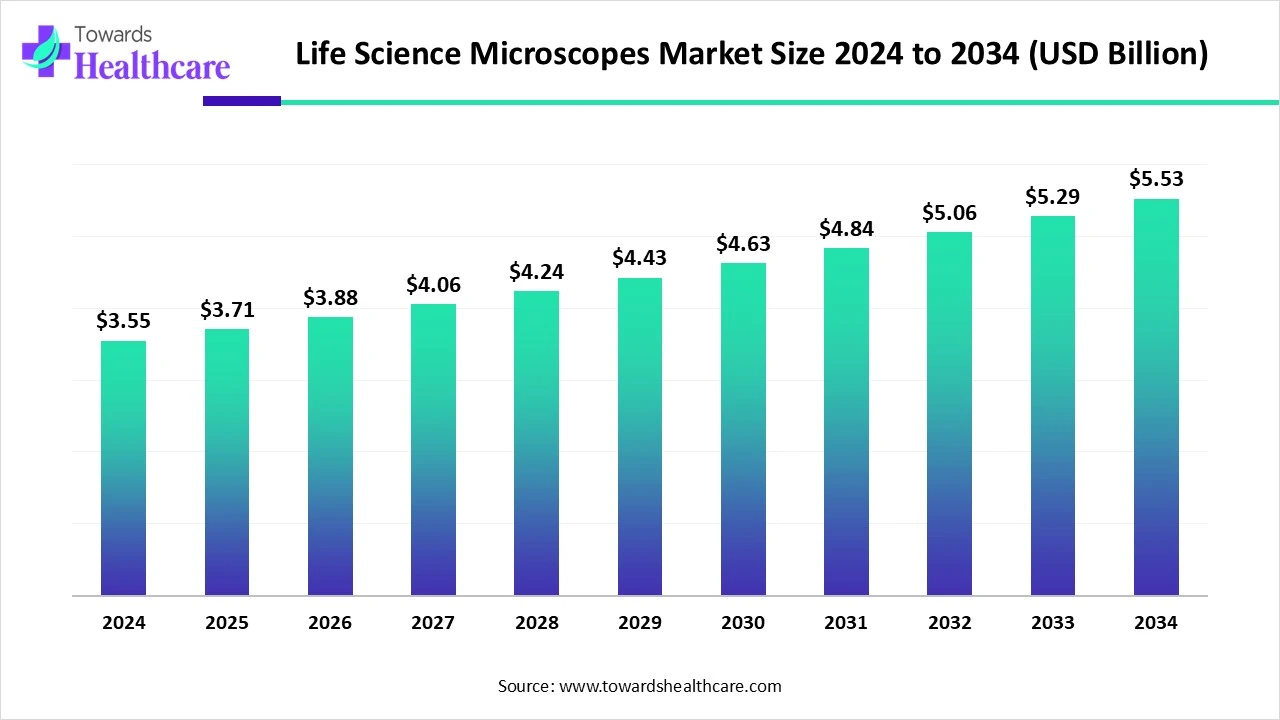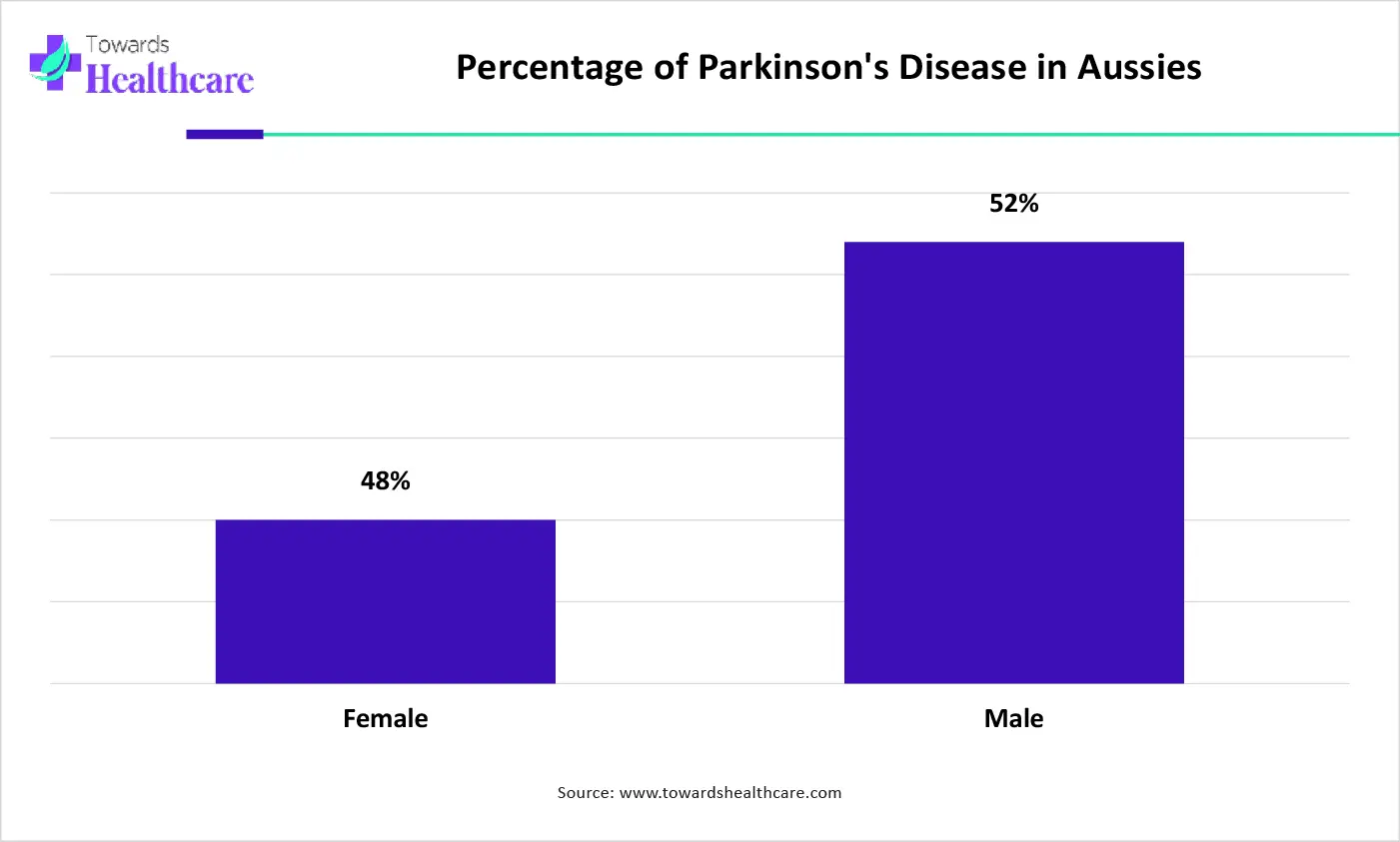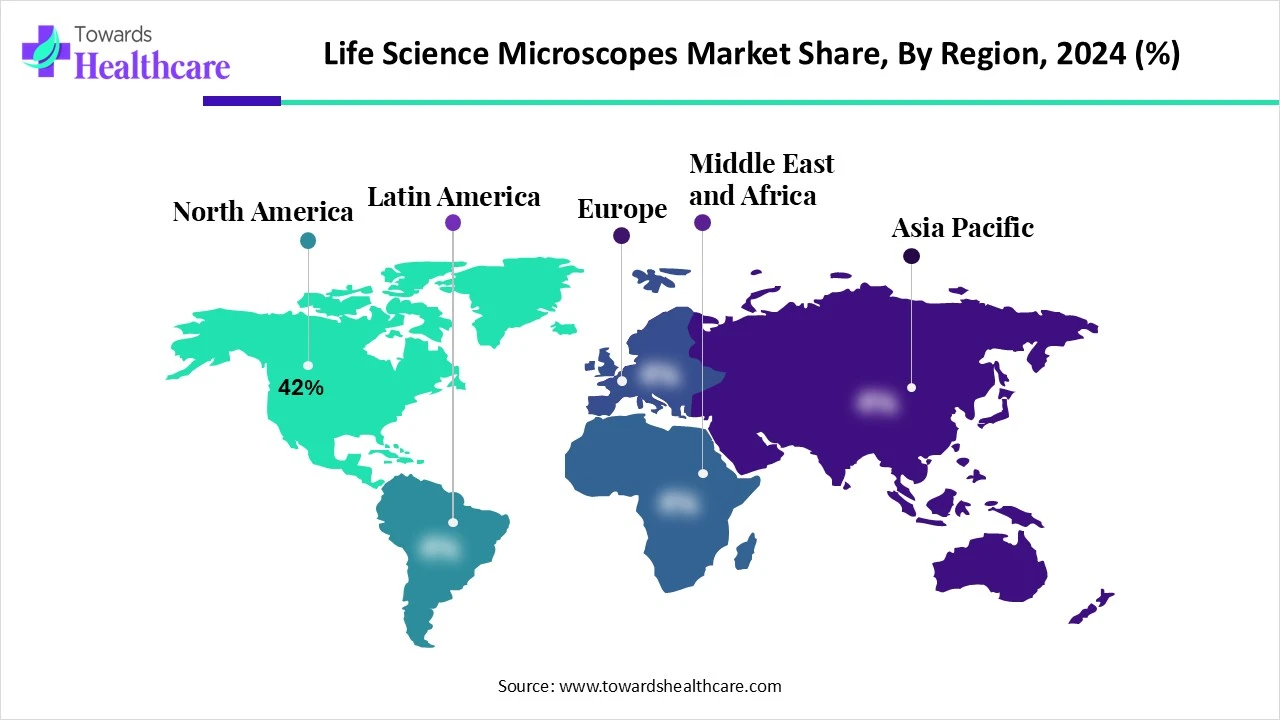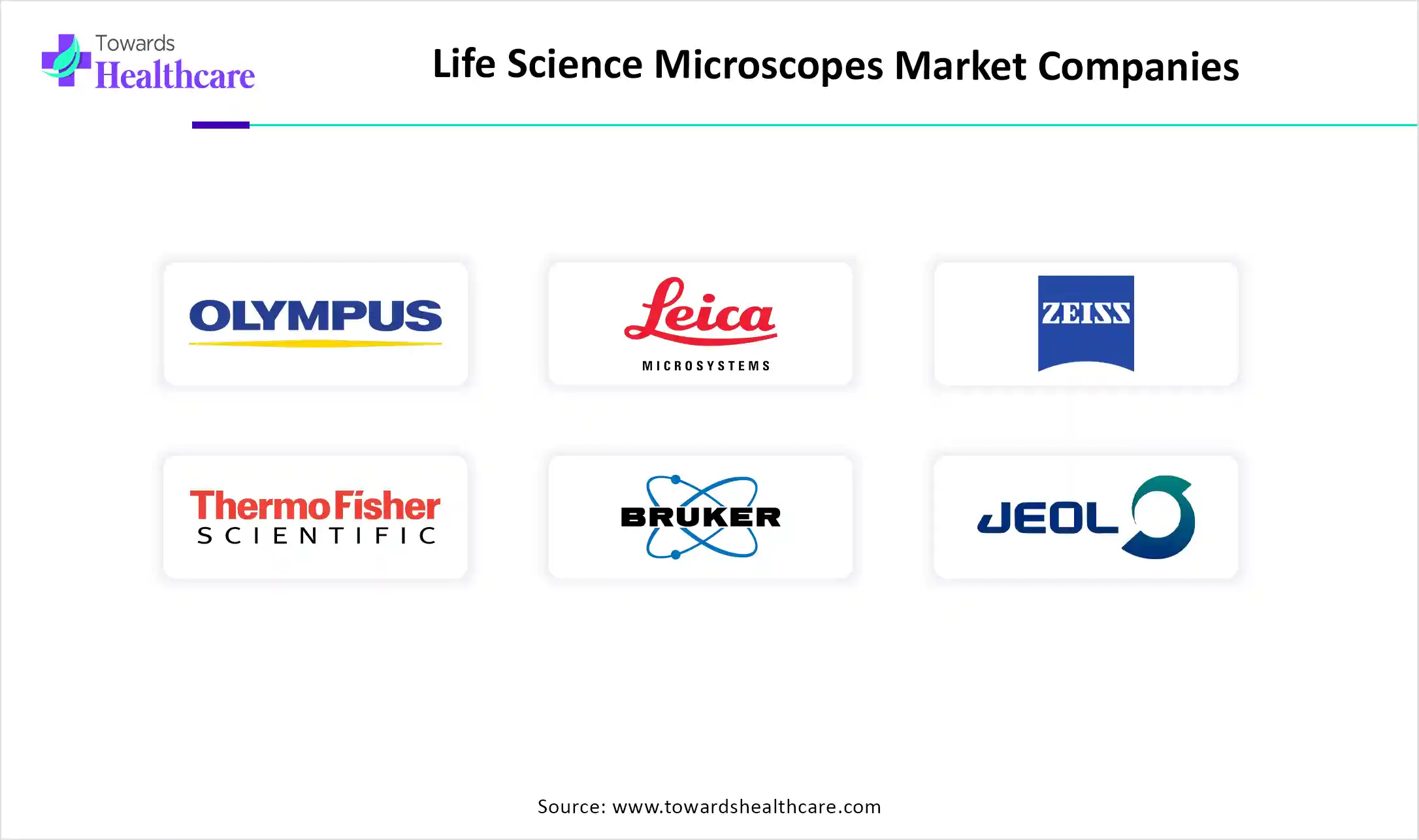December 2025

The global life science microscopes market size is calculated at US$ 3.55 billion in 2024, grew to US$ 3.71 billion in 2025, and is projected to reach around US$ 5.53 billion by 2034. The market is expanding at a CAGR of 4.55% between 2025 and 2034.

The growing drug discoveries and R&D are increasing the demand as well as the use of life science microscopes. Their advancements are being supported and encouraged by the investments and funding rounds conducted by the companies. Its applications are also being enhanced by integrating the microscopes with AI. Additionally, their demand in different regions is increasing due to the presence of well-developed industries, an expanding healthcare sector, and research. These developments are also being supported by the government. Thus, this promotes the market growth.
| Metric | Details |
| Market Size in 2025 | USD 3.71 Billion |
| Projected Market Size in 2034 | USD 5.53 Billion |
| CAGR (2025 - 2034) | 4.55% |
| Leading Region | North America share by 42% |
| Market Segmentation | By Product Type, By Application, By End User, By Technology, By Region |
| Top Key Players | Olympus Corporation, Leica Microsystems (Danaher Corporation), Carl Zeiss AG, Nikon Instruments Inc., Thermo Fisher Scientific, Bruker Corporation, JEOL Ltd., Hitachi High-Tech Corporation, KEYENCE Corporation, Asylum Research (Oxford Instruments), Bio-Rad Laboratories, Inc., PerkinElmer, Inc., FEI Company (Thermo Fisher), Agilent Technologies, Inc., Andor Technology Ltd. (Oxford Instruments), Hamamatsu Photonics K.K., CrestOptics, Evident Corporation (formerly Olympus Scientific Solutions), Photon, etc., Basler AG |
The life science microscopes market refers to the segment of microscopes used primarily in biological and biomedical research, diagnostics, and clinical applications. These microscopes are essential tools for visualizing cells, tissues, and biomolecules at high magnification and resolution. Life science microscopes include optical, electron, and scanning probe microscopes, among others. They are widely used in areas such as pathology, drug discovery, neuroscience, microbiology, and genetics. Technological advancements such as digital imaging, AI-powered analytics, super-resolution microscopy, and automation have significantly enhanced microscope capabilities, fueling demand in academic, clinical, and pharmaceutical research environments.
The accuracy, precision, and speed can be improved by using an AI algorithm in the analysis of a large volume of microscopic images. Moreover, the patterns and details that cannot be detected by the human eye can be easily detected. The human errors in image classification, segmentation, and feature extraction can be minimized with the help of AI and machine learning (ML), providing reproducible and reliable results. Furthermore, its use in personalized medicine development by analyzing individual microscopic images is also increasing.
Growing Research and Development
Research and development are increasing to develop novel diagnostic and treatment approaches for different diseases. This, in turn, increases the demand for life science microscopes. During the R&D, they are being used to detect and identify biomolecules, cells, and tissues. At the same time, their use in the development of personalized medicines or cell and gene therapies is also increasing. Moreover, the advanced microscopes with 3D imaging techniques are promoting their use. Thus, this drives the life science microscopes market growth.
High Cost
The life science microscopes, such as confocal, super-resolution, or electronic microscopes, are expensive. Moreover, their maintenance also adds to the cost. Thus, this limits their adoption by various startups and academics. This, in turn, decreases their use, limiting the market growth.
Advancements in Life Science Microscopes
To enhance the visualization, accuracy, and speed, as well as other features of microscopes, various innovations are being conducted. At the same time, to enhance the discovery of small structures, advanced microscopes are being developed. Thus, 3D imaging techniques along with advanced technologies are being used in their development, which in turn, is promoting their diagnostic applications. Additionally, techniques such as super-resolution and live cell imaging are also improving the research and development applications. Thus, this promotes the life science microscopes market growth.
For instance,

The graph represents the total number of patients with Parkinson's disease observed in the Aussies. It indicates that there will be a rise in cases of Parkinson's disease. Hence, it increases the demand for life science microscopes for its early diagnosis and effective management. Thus, this in turn will ultimately promote the market growth.
By product type, the optical microscopes segment held the largest share of approximately 53% in the market in 2024. They were widely used by various industries and institutes for research purposes. Moreover, due to its easy use and affordability, it was widely used. Thus, this contributed to the market growth.
By product type, the electron microscopes segment is expected to show the highest growth at a notable CAGR during the predicted time. Due to its higher resolution, its use is increasing. At the same time, for drug discovery and cell biology applications, its use is preferred. Furthermore, the growing innovations are encouraging their use.
By application type, the cell and molecular biology segment held the dominating share of approximately 40% in the market in 2024. In cell and molecular biology, microscopes were used to identify and understand the cell structure and function. They were also used in the development of next-generation therapies. This enhanced the market growth.
By application type, the drug discovery and development segment is expected to show the fastest growth rate during the upcoming years. The use of microscopes in drug discovery and development is increasing due to growing research. Moreover, to understand the drug responses and enhance drug development, its use is increasing.
By end user, the academic & research institutes segment led the global life science microscopes market with approximately 46% share in 2024. The microscopes were used in these institutes for research purposes. Moreover, the funding provided by the government encouraged their use. Thus, this promoted the market growth.
By end user, the pharmaceutical & biotechnology companies segment is expected to show the highest growth during the upcoming years. The growing development of new diagnostic and treatment approaches in these companies is increasing the use of microscopes. Additionally, new developments in these microscopes are also being made. The growing collaborations are also contributing to the same.
By technology type, the digital microscopy segment led the market with approximately a 58% share in 2024 and is expected to show the fastest growth rate during the predicted time. Digital microscopy provides high resolution with increased accuracy and precision. Hence, they are widely used for various research and development applications. Moreover, the growing advancements are driving their demand.

North America dominated the life science microscopes market share by 42% in 2024. North America consisted of well-developed industries, which enhanced the development of microscopes. Moreover, the use of advanced technologies improved their applications and development. Thus, this contributed to the market growth.
The U.S. consists of well-developed research institutes that focus on the development of new diagnostic as well as treatment approaches. This, in turn, increases the demand and use of life science microscopes. Moreover, the funding provided by the government is also supporting their research.
The expanding industries and the startups of Canada are increasing the demand for life science microscopes. Their use is increasing due to increased interest in genomics, proteomics, etc. Furthermore, AI-powered microscopes are also being developed to enhance their visualization.
Asia Pacific is expected to host the fastest-growing life science microscopes market during the forecast period. The healthcare sector in the Asia Pacific is expanding due to growing investments and research. Thus, this increases the utilization of various life science microscopes. Hence, this enhances the market growth.
The pharmaceutical as well as biotechnology industries in China are expanding. Hence, the development of various treatment approaches, drug discovery, and research is enhanced. This, in turn, increases the demand for life science microscopes. Moreover, the government initiatives are encouraging their adoption.
The growing research and development in Indian institutions and industries are increasing the use of microscopes. At the same time, growing incidences of diseases are driving their demand. Additionally, the investments and funding by various private and government sectors are enhancing their development.
Europe is expected to grow significantly in the life science microscopes market during the forecast period. The universities, as well as academic research institutes in Europe, are contributing to a variety of research. This increases the use of life science microscopes. Thus, this promotes the market growth.
The use of microscopes is increasing in various industries in Germany. They are increasingly used in the development of new diagnostic approaches, cell biology, and drug development. This, in turn, is increasing their development and is leading to new collaborations among the industries.
The growing research and development for genomics, as well as personalized treatment approaches in the UK, is increasing the demand for microscopes. At the same time, with the use of advanced technologies, innovations to enhance its features are also being made. These are further supported by the government investments.
The global life science market size is calculated at US$ 88.2 billion in 2024, grew to US$ 98.63 billion in 2025, and is projected to reach around US$ 269.56 billion by 2034. The market is expanding at a CAGR of 11.82% between 2025 and 2034.


By Product Type
By Application
By End User
By Technology
Conventional Microscopy
Digital Microscopy
Super-resolution Microscopy
Live-cell Imaging
AI-Powered Microscopy
By Region
December 2025
November 2025
October 2025
October 2025